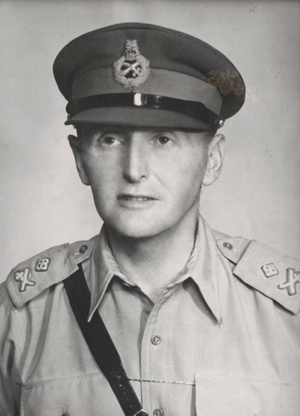Difference between revisions of "Terence Airey"
(bits and pieces) |
m (t) |
||
| Line 7: | Line 7: | ||
|interests=Operation Sunrise | |interests=Operation Sunrise | ||
|birth_place=Kings Lynn, Norfolk | |birth_place=Kings Lynn, Norfolk | ||
| − | |description=Early | + | |description=Early [[Bilderberg Steering committee]]. UK soldier |
|death_date=1983-03-26 | |death_date=1983-03-26 | ||
|death_place=Fritton, Norfolk | |death_place=Fritton, Norfolk | ||
Latest revision as of 18:33, 12 November 2020
(soldier, spook) | |
|---|---|
 | |
| Born | 1900-07-09 Kings Lynn, Norfolk |
| Died | 1983-03-26 (Age 82) Fritton, Norfolk |
| Nationality | British |
| Member of | Bilderberg/Steering committee |
| Interests | Operation Sunrise |
Early Bilderberg Steering committee. UK soldier | |
Lieutenant General Sir Terence Sydney Airey KCMG, CB, CBE was an intelligence officer in the British Army who was part of the delegation which tried to negotiate a separate peace with SS General Karl Wolff in 1944. Later, he was part of the Bilderberg Steering committee.
Contents
Military career
Before the Second World War
In 1919, Airey received a commission in the Durham Light Infantry. He later passed the Staff College and went on to serve as a staff officer in the Sudan in 1929 (where he became aquainted with Orde Wingate) and on the British Military Mission to the Egyptian Army.
Second World War
Airey was still involved in military affairs at the outbreak of the Second World War. In 1941, he was serving under General Sir William Platt in Abyssinia, after which he returned to General Headquarters in Cairo: there he was appointed Director of Special Operations and later Director of Military Intelligence. During the latter part of the Tunisian Campaign, Airey served as a Brigadier (General Staff) in the 18th Army Group.[1]
In June 1944, Airey was promoted major general and was later appointed Assistant Chief of Staff to General Harold Alexander. In this capacity, he flew to Switzerland with Lyman Lemnitzer, both disguised as Irish businessmen, to meet US intelligence operative Allen Dulles.
The three met the SS General Karl Wolff (who was very close to Himmler), with Airey trying to negotiate a meeting between Wolff and General Alexander to discuss the surrender of German forces in Italy. When the Soviets found out, the United States and United Kingdom were accused of going behind their allies' backs. Karl Wolff was later protected by Dulles and Lemnitzer, much to Airey's disdain. The Karl Wolff affair would later be known as Operation Sunrise.
One book about Sunrise describes him as "a British intelligence officer expert in European affairs and the German culture"[2], which implies that there is more to his career than the Middle East.
Postwar service
After the war, Airey served for a year as Chief of Staff to Commander-in-Chief of Central Mediterranean Forces and was for a time Acting Deputy Supreme Allied Commander in the Mediterranean Theatre.
In 1947, he was appointed Commander and Military Governor of the Anglo-American Zone, in the sensitive border city and area of Trieste, which was later split and handed over to the Italians and Yugoslavs. The position was originally intended to be only temporary, but Airey continued in it until 1951. He control over city and secured the important harbour for Italy. Before Airey arrived, the area had been under the power of a Communist temporary government.
After his service at Trieste, Airey was appointed Assistant Chief of Staff, Intelligence, to General Dwight D. Eisenhower at NATO's Supreme Allied Headquarters.
His last military appointment was as Commander of British Forces in Hong Kong from February 1952 to 1954. He retired from military service in 1954, but probably kept his intelligence connections.
In August 1956, he was appointed delegate-general of the European Foundation of Culture (which sounds an awful lot like a CIA front organization). The stated purpose was to revive the idea of Europe as a single cultural community.
Deep state connections
A member of the Bilderberg Steering committee.
Event Participated in
| Event | Start | End | Location(s) | Description |
|---|---|---|---|---|
| Bilderberg/1956 | 11 May 1956 | 13 May 1956 | Denmark Fredensborg | The 4th Bilderberg meeting, with 147 guests, in contrast to the generally smaller meetings of the 1950s. Has two Bilderberg meetings in the years before and after |
Events Witnessed
| Event | Location(s) | Description |
|---|---|---|
| Bilderberg/1955 March | France Barbizon | The second Bilderberg meeting, held in France. Just 42 guests, fewer than any other. |
| Bilderberg/1955 September | Germany Bavaria Garmisch-Partenkirchen | The third Bilderberg, in West Germany. The subject of a report by Der Spiegel which inspired a heavy blackout of subsequent meetings. |
References
- ↑ https://web.archive.org/web/20070731173330/http://www.kcl.ac.uk/lhcma/locreg/AIREY.shtml
- ↑ Disciples: The World War II Missions of the CIA Directors Who Fought for Wild Bill Donovan, by Douglas Waller, page 333